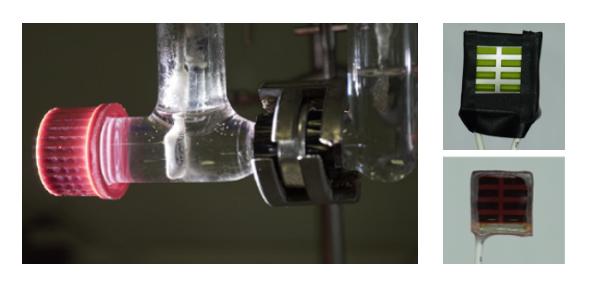
A collaboration between researchers from the University of Cambridge and Imperial College London demonstrated that artificial leaves made of readily available oxide and carbon-based materials can produce hydrogen from water over several weeks. The leaves, which consist of a few light harvesting spots (that is, pixels) showed a higher performance over conventional devices with a single larger pixel.
The researchers achieved this benchmark by sandwiching an Earth-abundant BiOI light absorber between two oxide layers. “These oxide layers improve the ability to produce hydrogen compared to stand-alone BiOI”, said Robert Jagt (Department of Materials Science and Metallurgy, University of Cambridge), one of the co-lead authors.
"We have been working on this material for some time, due to its wide-ranging potential applications, as well as its simplicity of fabrication, low toxicity and good stability. It was great to combine the expertise of the different research groups across Cambridge and with Imperial to demonstrate yet another potential application - clean hydrogen production.” Professor Judith Driscoll, Department of Materials Science and Metallurgy, University of Cambridge)
The robust oxide-based device structure was further coated with a water-repellent graphite paste, which prevented moisture infiltration. In this way, the stability of the BiOI light absorber could be prolonged from minutes to a couple of months, including the time the devices were left in storage. The devices could produce hydrogen for 500 h when dipped in solution, which is comparable with stability tests reported for some of the latest developed solar cells under air. These findings were published in the journal Nature Materials.
Despite the high performance of solar cells, the efficient storage of electricity still poses challenges. Solar fuels provide a promising alternative, by storing energy in the form of chemical bonds, which take less space over batteries. One of those energy carriers is hydrogen, which is expected to play an important role in transitioning towards a renewable economy.
This work was in part supported by the Cambridge Trust, the Winton Programme for the Physics of Sustainability, the Royal Academy of Engineering, the Engineering and Physical Sciences Research Council (EPSRC), and the European Research Council. Judith Driscoll is a Royal Academy of Engineering Chair in Emerging Technologies. Robert Hoye is a Royal Academy of Engineering Research Fellow. Virgil Andrei and Erwin Reisner are Fellows of St John’s College, Cambridge.

